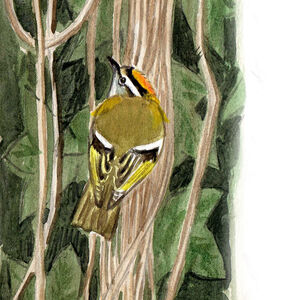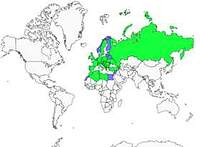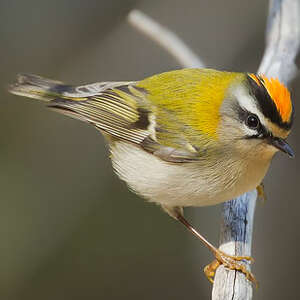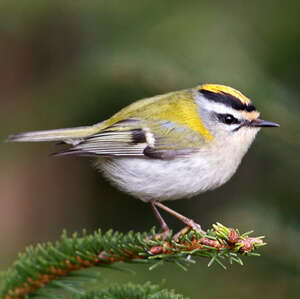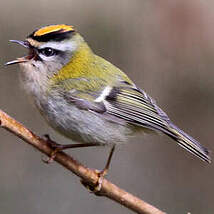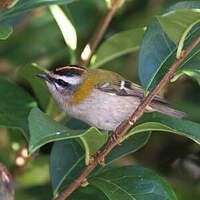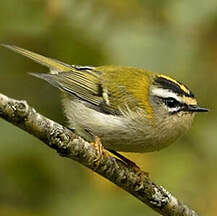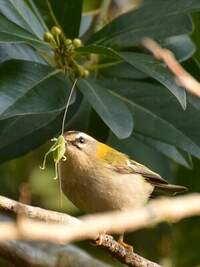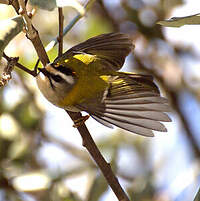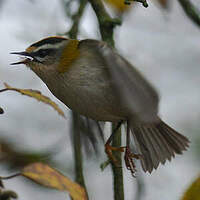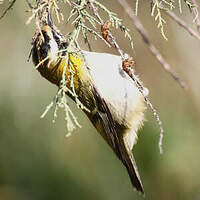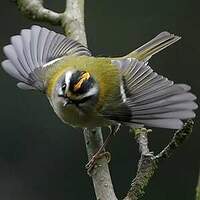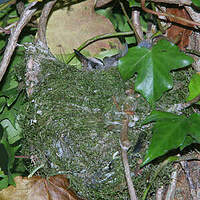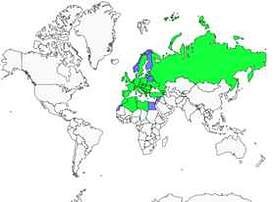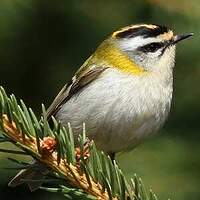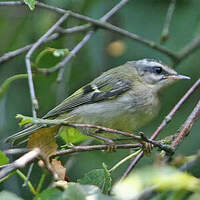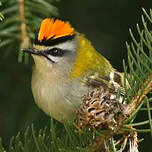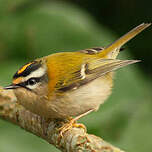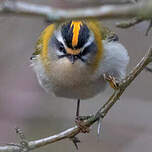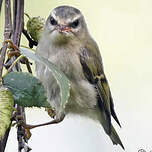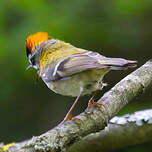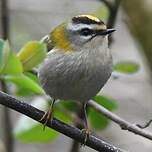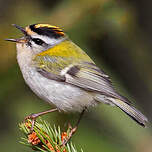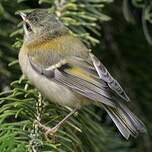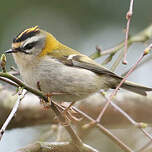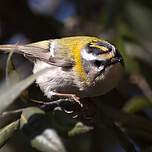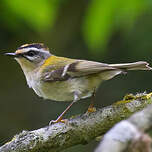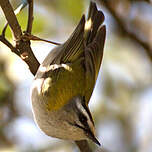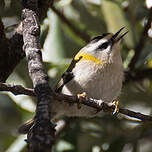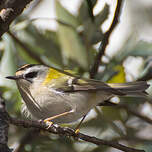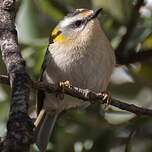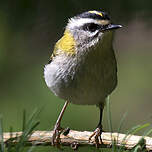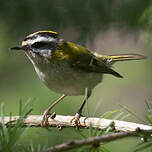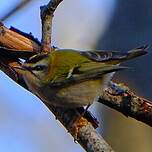Common Firecrest
Regulus ignicapilla - Roitelet triple-bandeau
Identification
The Common Firecrest is, alongside its humped cousin, one of the two smallest birds in Europe. The former weighs only 5 to 5.5 grams. At first glance they look like tiny green birds. To distinguish between them, the easiest way is through their song, although this is only applicable during spring. Otherwise one must look at their heads. The most visible difference is on the side. The Common Firecrest has a black band on the eye, which is very visible against the white background, while the Humped Firecrest does not have one. Just like its cousin, its crown has three longitudinal bands, a large, orange or yellow median band surrounded by two black ones. This is where the small sexual dimorphism lies. The median band is bright orange on the male, yellow on the female, sometimes tinted with orange. These colorful feathers can stand up into a short crest when the bird is excited or anxious. On the Common Firecrest, the black lateral bands on the crown are wider and more visible thanks to the wide white eyebrows. A white crescent accents the dark eye, which is in turn accented by a black moustache line. The Rtp (Common Firecrest) is more colorful above than its cousin. The nape, sides of the neck and cloak are a bright green-yellow. The forehead is golden and the cap of the male is a brighter orange. The undersides are paler, a slightly grayish white with the throat slightly creamy. The juvenile is duller in plumage, and can be recognized and distinguished from the Humped Firecrest by its head. The cap is gray, without the three bands of the adult. The sides of the head are marked by a white eyebrow and white arc under the eye which clearly stand out, in contrast to the uniformity that characterizes the young Humped Firecrest. The eye band is barely developed, and is a grayish color.
Subspecific information 4 subspecies
- Regulus ignicapilla ignicapilla (w, c and s Europe, Asia Minor)
- Regulus ignicapilla caucasicus (w Caucasus)
- Regulus ignicapilla tauricus (Crimea)
- Regulus ignicapilla balearicus (Balearic Is., nw Africa)
Foreign names
- Roitelet triple-bandeau,
- Reyezuelo listado,
- estrelinha-real,
- Sommergoldhähnchen,
- tüzesfejű királyka,
- Vuurgoudhaan,
- Fiorrancino,
- brandkronad kungsfågel,
- Rødtoppfuglekonge,
- králik ohnivohlavý,
- králíček ohnivý,
- Rødtoppet Fuglekonge,
- tulipäähippiäinen,
- bruel eurasiàtic,
- Gullkollur,
- zniczek (zwyczajny),
- sārtgalvītis,
- rdečeglavi kraljiček,
- Красноголовый королёк,
- マミジロキクイタダキ,
- 火冠戴菊,
- brandkronad kungsfågel,
- 火冠戴菊,
Voice song and call
The calls of the Common Firecrest are high-pitched whistles, sometimes with a slightly unrefined tone, which differentiates them from the Hoopoe's. Its song is a rapid sequence of identical high notes related to the calls ssississississississi ...srrr with a brief different final pattern. So, a simplistic and monotonous song, different from the Hoopoe's modulated singing, but loud for the size of the bird.
Habitat
Like the Marsh Tit, the Common Firecrest occupies natural alpine, scrubland, and pine forests, as well as plantations of spruce or exotic species. But unlike the Marsh Tit, it can be found in mixed forests and even pure deciduous forests when habitat features such as the presence of ivy on the trees or evergreen foliage such as that of holly or cork oak are favored. In the Maghreb, it is present in cedar forests at altitudes of over 1600m.
Behaviour character trait
As Common Firecrest, like the Great Tit, is an unassuming bird that can be observed up close when the opportunity arises.
It stands out with its rapid wing movements when it is active, quickly hopping from branch to branch in search of food, quickly picking small insects with its beak. In Spring, it can be detected by its call, before being spotted with the eyes. During Winter, it can join tit flocks and other small birds. Its bright colours on its head play a role in communication between individuals of the same species within dense vegetation, especially for courtship during the breeding season or to feed juvenile birds that have left their nests. The species performs partial migration and approaches the Mediterranean in winter, becoming common in countries such as Spain, to the west and south of the Black Sea, with its numbers decreasing correspondingly to the north of its nesting area. It performs what is known as a creeping migration during daytime, moving from one bush to another in the right direction. Important migrations take place at night, allowing them to avoid most predators. The passage of these migrants can be detected at monitoring sites with its high-pitched cries.Flight
With its 5.5 grams and its small, relatively rounded wings, the Common Firecrest does not seem to be geared towards migratory behavior, yet...hundreds of kilometers are traveled. Flight is direct and rather fast for its size, not very undulating. When it looks for food, it knows how to flutter among the trees, hovering in place to seize a prey.
Dietfeeding habits
As with all kinglets, the Common Firecrest feeds exclusively on insects. Whereas the Rufous-tailed Robin systematically hunts through dense foliage and mainly under branches and leaves, the Common Firecrest prefers to hunt prey that are perched or catch them while flying in more open contexts.
This is a way of not competing too much in sympatric situations. It eats small insects, but bigger ones than those of the slightly smaller Rufous-tailed Robin. The larger prey is handled with the beak, knocked against a branch, softened, before being swallowed.Reproduction nesting
The Common Firecrest breeding season runs from April to August, and double broods are possible. They most often nest in tall conifers, often over 10 metres up.
If conifers are not available they will nest in ivy along a trunk or branch, in wild vines or other climbing plants, as a last resort in a well-leafed deciduous branch; in the south, it can be replaced with an evergreen. Their nest is spherical with thick walls in 3 layers, with an opening at the top; it is mainly built of moss, lichen and twigs held together with cobwebs. The inside is lined with hundreds of feathers. Whereas the European Pied Flycatcher will construct their nest between both partners, the Common Firecrest's nest is only built by the female, sung to by the male. The clutch size is typically 7 to 9 (6 to 13) greyish eggs, which incubate for 2-15 days. The nestlings will leave the nest after 3 weeks, and remain dependent on the adults, especially the male, for another 3 weeks until they get their juvenile plumage for the next 3 months.Geographic range
The breeding range of the Common Firecrest is mainly European, with extensions in the Maghreb and Anatolia. It is found on Mediterranean islands, except Cyprus. It is a bird of temperate and Mediterranean forests, so it is absent in Scandinavia, Ireland and the north of the British Isles. Birds from the northeast of its range are migratory and winter south to the Mediterranean, pushing east to Anatolia via the Bosphorus and, perhaps, Morocco via Gibraltar.
Threats - protection
Sources of information
- IOC World Bird List (v14.2), Gill, F and D Donsker (Eds). 2024-04-18.
- Les passereaux d'Europe, tome 2, P. Géroudet, M. Cuisin
- Avibase, Lepage Denis
- Birds of the World, The Cornell Lab of Ornithology
- xeno-canto, Sharing bird sounds from around the world,
Other sources of interest
 Specification sheet created on
13/07/2023 by Jean François
Specification sheet created on
13/07/2023 by Jean FrançoisTranslation by AI Oiseaux.net
© 1996-2025 Oiseaux.net
- Accipitriformes
- Aegotheliformes
- Anseriformes
- Apodiformes
- Apterygiformes
- Bucerotiformes
- Caprimulgiformes
- Cariamiformes
- Casuariiformes
- Charadriiformes
- Ciconiiformes
- Coliiformes
- Columbiformes
- Coraciiformes
- Cuculiformes
- Eurypygiformes
- Falconiformes
- Galliformes
- Gaviiformes
- Gruiformes
- Leptosomiformes
- Mesitornithiformes
- Musophagiformes
- Nyctibiiformes
- Opisthocomiformes
- Otidiformes
- Passeriformes
- Pelecaniformes
- Phaethontiformes
- Phoenicopteriformes
- Piciformes
- Podargiformes
- Podicipediformes
- Procellariiformes
- Psittaciformes
- Pterocliformes
- Rheiformes
- Sphenisciformes
- Steatornithiformes
- Strigiformes
- Struthioniformes
- Suliformes
- Tinamiformes
- Trogoniformes

